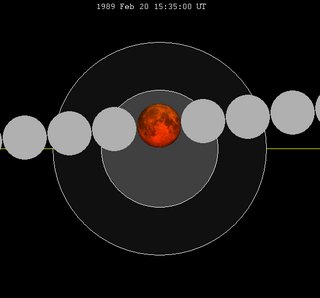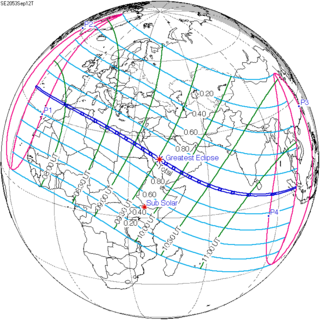
A total lunar eclipse took place on Friday, February 9, 1990, the first of two lunar eclipses in 1990.

A penumbral lunar eclipse took place on Sunday 24 April 2005, the first of two lunar eclipses in 2005. At maximum eclipse, 86.5% of the Moon's disc was partially shaded by the Earth, which caused a slight shadow gradient across its disc; this subtle effect may have been visible to careful observers. No part of the Moon was in complete shadow. The eclipse lasted 4 hours and 6 minutes overall, and was visible from east Asia, Australia, and the Americas.

A total lunar eclipse took place on Monday, February 20, 1989, the first of two total lunar eclipses in 1989.

A partial lunar eclipse took place on Monday, March 24, 1997, the first of two lunar eclipses in 1997.

A total lunar eclipse took place on 4 April 2015. It is the former of two total lunar eclipses in 2015, and the third in a tetrad. Other eclipses in the tetrad are those of 15 April 2014, 8 October 2014, and 28 September 2015.
A penumbral lunar eclipse took place on 23 March 2016, the first of three lunar eclipses in 2016. The Moon was just 2.1 days before apogee, making it very small, so this was a "Micromoon" penumbral lunar eclipse.

A penumbral lunar eclipse took place on 16 September 2016, the last of three lunar eclipses in 2016.
A penumbral lunar eclipse took place on Thursday, March 3, 1988, the first of two lunar eclipses in 1988, the second being on August 27, 1988. Earlier sources compute this as a 0.3% partial eclipse lasting under 14 minutes, and newest calculations list it as a penumbral eclipse that never enters the umbral shadow. In a rare total penumbral eclipse, the entire Moon was partially shaded by the Earth, and the shading across the Moon should have been quite visible at maximum eclipse. The penumbral phase lasted for 4 hours, 53 minutes and 50.6 seconds in all, though for most of it, the eclipse was extremely difficult or impossible to see. The Moon was 2.2 days after apogee, making it 6.1% smaller than average.
A penumbral lunar eclipse took place on Tuesday, April 14, 1987, the first of two lunar eclipses in 1987, the second being on October 7, 1987. This subtle penumbral eclipse may have been visible to a skilled observer at maximum eclipse. 77.703% of the Moon's disc was partially shaded by the Earth, which caused a gentle shadow gradient across its disc at maximum; the eclipse as a whole lasted 3 hours, 54 minutes and 12.8 seconds. The Moon was just 4.6 days before perigee, making it 0.5% larger than average.

A partial lunar eclipse occurred on 19 November 2021. The eclipse occurred towards a micromoon. This was the longest partial lunar eclipse since 18 February 1440, and the longest until 8 February, 2669; however, many eclipses, including the November 2022 lunar eclipse, have a longer period of umbral contact at next to 3 hours 40 minutes. It was often referred to as a "Beaver Blood Moon" although not technically fulfilling the criteria for a true blood moon (totality).
A penumbral lunar eclipse will take place on Monday, March 25, 2024. It will be visible to the naked eye as 95.57% of the Moon will be immersed in Earth's penumbral shadow.
A partial lunar eclipse will take place on Wednesday, 18 September 2024, the second of two lunar eclipses in 2024 and the final partial lunar eclipse of Lunar Saros 118.
A partial lunar eclipse took place on Tuesday, March 13, 1979, the first of two lunar eclipses in 1979. The Moon was strikingly shadowed in this deep partial eclipse which lasted 3 hours, 17 minutes and 40.6 seconds, with 85.377% of the Moon in darkness at maximum.
A penumbral lunar eclipse took place on Saturday, March 1, 1980, the first of three penumbral lunar eclipses in 1980. This subtle penumbral eclipse may have been visible to a skilled observer at maximum eclipse. 65.455% of the Moon's disc was partially shaded by the Earth, which caused a gentle shadow gradient across its disc at maximum; the eclipse as a whole lasted 3 hours, 58 minutes and 33.3 seconds.
A penumbral lunar eclipse took place on Wednesday, April 2, 1969, the first of three penumbral lunar eclipses in 1969, the second being on Wednesday, August 27, and the last being on Thursday, September 25. This subtle penumbral eclipse may have been visible to a skilled observer at maximum eclipse. 70.337% of the Moon's disc was partially shaded by the Earth, which caused a gentle shadow gradient across its disc at maximum; the eclipse as a whole lasted 3 hours, 43 minutes and 46.9 seconds. Occurring only 4.2 days before perigee, the Moon's apparent diameter was 0.9% larger than average.

A total lunar eclipse took place on Sunday, March 13, 1960. The moon passed through the center of the Earth's shadow.

A total lunar eclipse will take place on February 11, 2055.

A total solar eclipse will take place at the Moon's ascending node of the orbit on Friday, September 12, 2053 with a magnitude of 1.0328. A solar eclipse occurs when the Moon passes between Earth and the Sun, thereby totally or partly obscuring the image of the Sun for a viewer on Earth. A total solar eclipse occurs when the Moon's apparent diameter is larger than the Sun's, blocking all direct sunlight, turning day into darkness. Totality occurs in a narrow path across Earth's surface, with the partial solar eclipse visible over a surrounding region thousands of kilometres wide.

A penumbral lunar eclipse took place on Friday, March 23, 1951. This subtle penumbral eclipse may have been visible to a skilled observer at maximum eclipse. 64% of the Moon's disc was partially shaded by the Earth, which caused a gentle shadow gradient across its disc at maximum; the eclipse as a whole lasted 3 hours and 34 minutes.

A penumbral lunar eclipse will take place on August 29, 2053.































